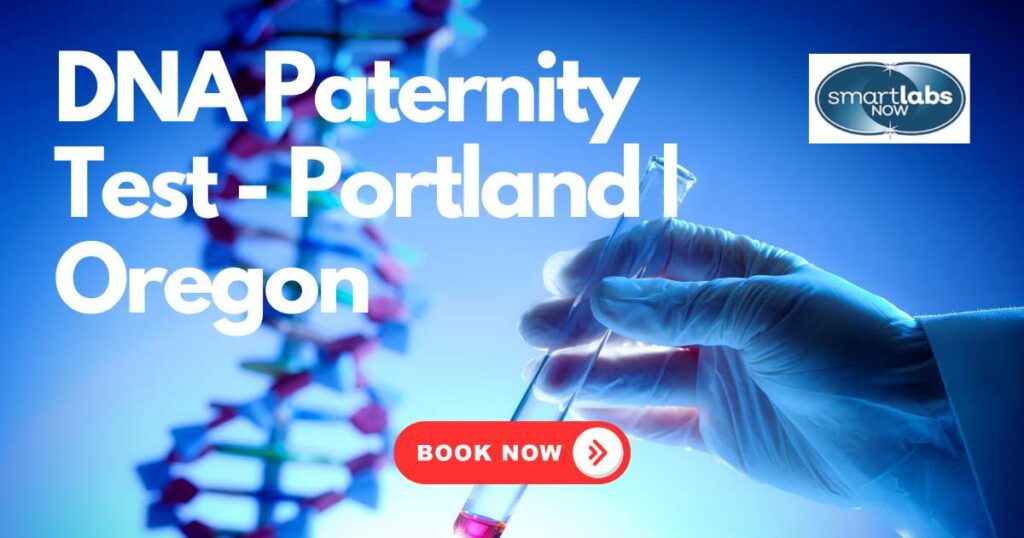
A DNA paternity test provides a reliable way to confirm biological relationships, offering clarity in sensitive situations.
At Smart Labs Now, we specialize in accurate, affordable, and discreet DNA testing for Portland residents.
Whether you’re seeking answers for personal reasons or need legal confirmation, we offer testing solutions designed to give you definitive results.
Schedule NOW to prioritize your health with our gentle and professional testing services.
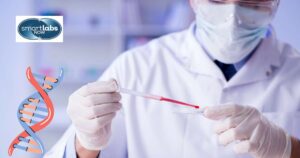
A DNA paternity test uses genetic analysis to determine if someone is the biological parent of a child. This advanced, highly accurate process is commonly used for personal, legal, or medical purposes.
A 2024 study by Apollo Hospitals compares the DNA of the alleged father with the child’s DNA to determine biological paternity.
Analyzes DNA inherited from both parents.
Compares genetic markers between the potential father and child.
Each individual has unique genetic fingerprints, ensuring precise identification.
Uses the mother’s blood sample during pregnancy, offering a safe and accurate test.
Tracks paternal lineage through the Y chromosome passed from father to son.
Establishing paternity provides legal, emotional, financial, and medical advantages for both the child and the parents.
A confirmed biological relationship ensures parental rights, financial security, and access to crucial medical history, benefiting the child’s overall well-being.
Whether determined voluntarily, through a legal process, or via DNA testing, proving paternity has far-reaching effects in multiple areas of life.
Legally recognized paternity ensures the child receives financial support from both parents, contributing to basic needs such as education, healthcare, and daily expenses.
A child gains legal rights to the father’s estate, inheritance, and life insurance coverage, securing future financial stability.
Legal acknowledgment of paternity also helps establish parental responsibilities, protecting both the child’s and the father’s interests in custody and visitation disputes.
Knowing both parents’ medical histories helps assess potential genetic conditions, hereditary diseases, and predispositions to health issues.
This information is crucial for preventative care and treatment.
Having access to genetic health information allows doctors to develop personalized healthcare plans that consider familial risks, leading to better health outcomes.
Knowing one’s biological roots helps foster a sense of self-identity, reducing feelings of confusion or relational strife.
Research suggests that children with established paternity often exhibit higher cognitive abilities, emotional security, and better social adjustment compared to those uncertain about their parentage.
Legal recognition of paternity can encourage stronger father-child bonds, leading to emotional closeness and a positive impact on a child’s upbringing.
For fathers, confirming paternity often deepens their sense of responsibility and involvement, leading to more engaged parenting and support.
Paternity can be established through voluntary acknowledgment, legal procedures, or DNA testing. In disputed cases, court-admissible DNA tests ensure clarity while protecting the rights of all involved parties.
Whether for legal, medical, or emotional reasons, confirming paternity plays a critical role in ensuring stability, security, and personal well-being for both the child and parents.
When seeking a DNA paternity test, individuals have the option to schedule an in-lab test at accredited facilities or opt for an at-home testing kit.
The choice depends on whether the test is needed for legal purposes or personal peace of mind.
Understanding the scheduling process, sample collection methods, and available locations ensures a smooth and efficient testing experience.
Many DNA testing providers offer convenient online scheduling to select a preferred location, date, and time.
Some labs provide same-day testing options, catering to urgent testing needs.
If an in-lab visit is inconvenient, individuals can order in-home DNA test kits, collect a cheek swab, and return the sample via mail.
Court-admissible paternity tests require sample collection at state-of-the-art accredited labs with strict chain-of-custody protocols.
For those requiring a DNA test for legal reasons, such as child support, custody cases, or immigration applications, it is essential to choose a legally recognized facility that meets industry standards.
Multiple testing centers across the country offer DNA paternity testing. For individuals in and around Portland, Oregon, SmartLabsNow provides advanced, accredited DNA testing services with a reputation for accuracy, reliability, and confidentiality.
We offer:
For those unable to visit a physical location, SmartLabsNow also offers DNA testing kit shipping options, allowing individuals to collect their samples in the privacy of their own homes while ensuring secure and accurate testing.
The most common DNA sample collection method is a cheek swab, which is painless and non-invasive. However, alternative specimen testing is available in certain cases, using:
Choosing a trusted and accredited facility ensures accurate results, whether the test is conducted in a laboratory or through an at-home kit.
With professional DNA testing centers like SmartLabsNow, individuals in Portland and surrounding areas can expect high-quality service, fast turnaround times, and expert assistance in navigating the testing process.
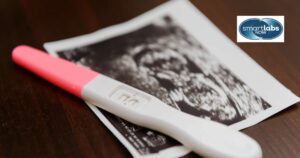
A DNA paternity test follows a structured process, ensuring accuracy and reliability.
The procedure varies based on whether the test is conducted before birth (prenatal) or after birth (postnatal).
Additionally, multiple testing techniques are available, each tailored to specific situations and accuracy requirements.
A 2024 study by the Feldstein Family Law Group discusses non-invasive DNA sampling techniques, including buccal swabs and prenatal testing through maternal blood samples.
Prenatal testing determines paternity before the child is born. It can be non-invasive (using the mother’s blood) or invasive (requiring direct sample collection from the pregnancy).
Extracts fetal DNA from the mother’s bloodstream, offering a safe and highly accurate test without risk to the pregnancy.
For cases requiring direct fetal DNA, invasive methods provide highly reliable results but involve minor medical risks.
A small sample of amniotic fluid is collected using a thin needle containing fetal DNA for analysis.
Placental tissue samples are taken to analyze genetic material.
Sometimes used alongside invasive methods to further validate relationships, particularly in complex legal or medical cases.
Once the child is born, paternity can be confirmed using minimally invasive sample collection methods.
The most common and painless method, where a cotton swab is used to collect DNA cells from the inside of the cheek.
While not conclusive, blood type analysis can help support genetic compatibility findings.
In certain cases, alternative biological samples may be tested when cheek swabs are not available.
Various laboratory techniques ensure that DNA samples are accurately analyzed for biological relationships.
A widely used technique that amplifies small DNA samples to ensure precise analysis, even with degraded or limited genetic material.
Compares specific DNA fragments to determine biological relationships with high accuracy.
Primarily used in medical testing and bone marrow compatibility, but also useful in specific kinship DNA tests.
Each testing method is carefully chosen based on individual needs, legal requirements, and the most suitable sample type for reliable results.
Whether performed prenatally or postnatally, modern DNA analysis techniques ensure precise and legally valid outcomes.
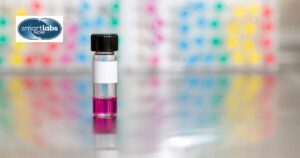
DNA paternity tests are highly accurate, often exceeding 99.9%. These results are considered reliable for legal purposes.
This 2023 study by Smart DNA highlights that paternity tests are highly accurate, with a probability of paternity typically being 99.99% or higher when a match is found at all tested loci.
Ensures laboratories meet international testing standards.
Provides statistical probability of paternity.
Sample integrity, lab accreditation, and advanced genetic analysis ensure accuracy.
Modern breakthroughs have enhanced the accuracy and accessibility of paternity testing.

DNA testing is often used in resolving legal matters like child custody, inheritance, and immigration. Compliance with legal standards ensures test results are valid in court.
A 2023 study by AlphaBiolabs UK discusses legal requirements for DNA testing, including consent and parental responsibility.
AABB accreditation ensures labs meet strict standards for legal credibility.
ISI 17025 confirms the reliability of testing methods and equipment.
Proper documentation of sample handling is essential for court-admissible tests.
Paternity tests may be mandated in custody or support disputes.
The primary difference between legal and at-home tests is court admissibility.
Legal tests are conducted under supervision, with a documented chain of custody, making them valid for use in family courts, immigration, and inheritance cases.
At-home tests lack this oversight and are not admissible in legal contexts.

Cost and Accessibility of DNA Paternity Tests
DNA paternity tests vary in cost depending on the type of test, the level of accuracy required, and whether the results need to be legally admissible.
Additionally, accessibility factors such as testing availability, consent requirements, and alternative sample sources can influence the process.
The cost of a paternity test is influenced by the method used, sample type, and whether the test is for personal or legal purposes.
Note: (*) Indicates that the prices may be subject to change and to always call and check the current prices
DNA testing is widely available, but certain factors can affect accessibility:
The most commonly used method due to its non-invasive nature and ease of collection.
If the father is unavailable, samples from paternal relatives (e.g., grandparents or siblings) may be used to establish genetic relationships.
Some states require consent from all parties involved, including the child’s legal guardian, before proceeding with testing.
In some cases, fathers can sign a legal affidavit recognizing paternity without DNA testing, which may be sufficient for legal and administrative purposes.
DNA testing plays a crucial role in legal cases and immigration applications:
Choosing an AABB-accredited laboratory ensures results meet international standards for legal use.
✔️ Determine the purpose of the test (personal vs. legal).
✔️ Confirm sample collection requirements (cheek swab, blood, or prenatal).
✔️ Verify if consent or legal authorization is needed in your state.
✔️ Check if testing is covered by insurance (for medical reasons).
✔️ Ensure the lab is accredited for legal and immigration cases.

At-home DNA paternity tests offer a private, cost-effective, and accessible solution for individuals seeking clarity about biological parentage.
These tests allow users to collect samples themselves and send them to a laboratory for analysis, eliminating the need for an in-clinic appointment.
However, while at-home tests provide convenience, they have limitations in legal admissibility and sample integrity, making them suitable for personal use but not for legal matters.
The process of conducting an at-home DNA paternity test is straightforward:
At-home paternity tests are highly accurate, with most results providing a 99.99% probability of paternity when a match is found.
However, factors such as contamination, improper sample collection, or degraded DNA can impact the reliability of results.
To enhance accuracy, laboratories use:
These certifications ensure that the lab meets rigorous standards for genetic testing.
In cases where standard DNA comparison is inconclusive, mitochondrial DNA may be analyzed to track maternal lineage.
Although at-home tests are useful for personal knowledge, they are not legally admissible in cases involving child custody, immigration, inheritance, or child support claims.
Courts require a documented chain of custody, ensuring that samples are collected under supervision in a certified facility to prevent tampering or misidentification.
Must be conducted by an AABB-accredited laboratory, with sample collection performed by a certified professional.
At-home DNA tests provide a valuable option for individuals seeking personal confirmation of paternity, but for official legal matters, a supervised laboratory test remains the gold standard.
Understanding the timeline for receiving results after submitting DNA samples is essential for those undergoing a paternity test.
After samples are collected and sent to the laboratory, the processing times can vary based on the complexity of the test and the services selected.
Typically, clients can expect a turnaround time of 3 to 5 business days from the moment the laboratory receives their samples.
For those in dire need of expedited results, Smart Labs Now offers rush testing options, allowing for a quickened processing timeframe that can yield results in 2 business days.
This accelerated service is especially valuable for individuals who require prompt answers for legal, emotional, or personal reasons.
Once processed, results are communicated securely via a password-protected email to ensure confidentiality.
This feature highlights the commitment to privacy while providing clients with easy access to their results, fostering peace of mind as they wait for the outcomes of their tests.
By clearly understanding these timelines and options, individuals can better prepare for the emotional and practical implications of the results
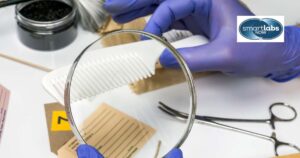
Hair DNA testing is an alternative to cheek swabs, offering distinct advantages and challenges:
A negative paternity test result confirms that the alleged father is not biologically related to the child.
This determination is based on DNA analysis, which compares genetic markers between the child and the tested individual.
If the tested man’s DNA does not match the child’s, he is excluded as the biological father.
Negative results can have significant legal, emotional, and social implications, affecting family court decisions, immigration applications, and access to social security benefits.
Understanding the accuracy, documentation, and implications of such results is essential.
DNA paternity tests analyze specific genetic markers using methods like Short Tandem Repeats (STR) analysis and Polymerase Chain Reaction (PCR) to identify inherited traits.
A Combined Paternity Index (CPI) is calculated to measure the probability of paternity:
The alleged father is excluded and is not the biological parent.
The alleged father is highly likely to be the biological parent.
Negative results are highly reliable when tests are conducted in accredited laboratories, ensuring accurate sample handling and analysis.
A negative paternity test result has various legal and social consequences, depending on whether the test was conducted for informational purposes or legal matters:
In child custody and support cases, a court-admissible legal paternity test can exempt an excluded individual from financial obligations.
DNA tests are often required in immigration applications to prove a biological relationship between a petitioner and a beneficiary. A negative result may lead to the denial of an immigration application.
A child’s eligibility for inheritance, life insurance, and government benefits may be impacted if the tested individual is not the biological father.
For legal use, paternity tests must follow strict chain-of-custody protocols and be conducted in AABB-accredited laboratories to be recognized by courts and government agencies.
Receiving a negative paternity test result can be an emotionally challenging situation for all parties involved.
The alleged father, child, and other family members may experience shock, confusion, or distress.
A negative paternity test provides scientific certainty in disputed cases, but it also carries legal, social, and emotional consequences that require careful handling.
Whether conducted for personal clarity or legal verification, understanding the next steps is crucial for moving forward.
Including the mother’s DNA in the test improves accuracy by isolating the child’s genetic markers from the mother’s, making the father’s contribution clearer.
Testing without the mother’s DNA is possible but less accurate. Alternatives like sibling, avuncular, or grandparent DNA tests can also be used.
This 2023 study by Smart DNA highlights that the biological mother’s DNA can improve test accuracy by distinguishing which alleles the child inherited from the mother.
DNA paternity testing provides highly accurate results, but certain risks and considerations must be acknowledged before proceeding.
These factors include potential emotional, medical, and technical challenges that could impact the testing process and its outcomes.
Prenatal DNA testing, particularly invasive procedures, carries some medical risks that should be carefully considered:
This procedure involves extracting amniotic fluid, which poses a small risk of miscarriage or premature labor.
While useful for obtaining fetal DNA, CVS may slightly increase miscarriage risks and is generally only recommended when necessary.
Invasive prenatal testing methods should only be performed under medical guidance to minimize potential harm to both mother and fetus.
For individuals concerned about these risks, Non-Invasive Prenatal Paternity Testing (NIPP) offers a safer alternative without requiring direct fetal sample collection.
Beyond the scientific aspects, DNA testing can have serious emotional and psychological implications:
Discovering unexpected results can lead to emotional distress, family tension, and relationship strain.
The accessibility of DNA testing has led to an increase in cases where paternity is questioned, sometimes causing familial and societal conflicts.
In some cases, results may lead to legal battles over custody, child support, or inheritance rights.
Before proceeding with a test, individuals should consider seeking legal and psychological guidance, especially in sensitive cases.
While DNA paternity tests are highly accurate, certain factors can affect test reliability and interpretation:
Choosing an accredited laboratory with ISO 17025 certification ensures high-quality testing standards and minimizes errors.
Before undergoing a DNA paternity test, individuals should:
✔️ Weigh the emotional and legal impact of potential results.
✔️ Understand the risks associated with invasive prenatal testing.
✔️ Ensure proper sample collection to avoid inaccurate results.
✔️ Use a legally accredited lab if the test is required for court cases.
By being aware of these risks and considerations, individuals can make an informed decision and ensure a smooth testing process with reliable outcomes.
Smart Labs Now offers Quick, Affordable, Discreet, & Accurate DNA Paternity Testing in Portland | Oregon 👋
Connect with us today for in-lab or on-site testing.
Gain court-admissible certainty of biological parentage 👍
BOOK NOW to experience fast, accurate, and affordable testing today.
DISCLAIMER:
Please consult your primary care physician before engaging with any pharmaceutical, natural substances, or activity regimens mentioned or prescribed in this post. Smart Labs Now is not responsible for health or life outcomes based on the information or recommendations provided. This account does not serve as a substitute for professional medical advice/help.